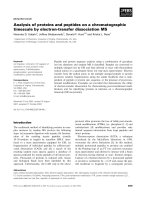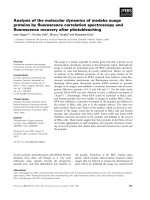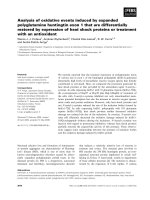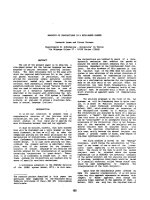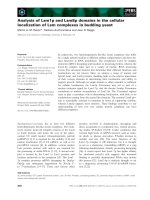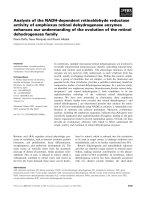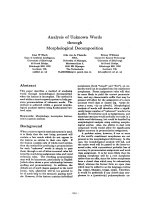Báo cáo khoa học: "Analysis of Mixed Natural and Symbolic Language Input in Mathematical Dialogs" pdf
Bạn đang xem bản rút gọn của tài liệu. Xem và tải ngay bản đầy đủ của tài liệu tại đây (131.02 KB, 8 trang )
Analysis of Mixed Natural and Symbolic Language Input
in Mathematical Dialogs
Magdalena Wolska Ivana Kruijff-Korbayov´a
Fachrichtung Computerlinguistik
Universit¨at des Saarlandes, Postfach 15 11 50
66041 Saarbr¨ucken, Germany
magda,korbay @coli.uni-sb.de
Abstract
Discourse in formal domains, such as mathemat-
ics, is characterized by a mixture of telegraphic nat-
ural language and embedded (semi-)formal sym-
bolic mathematical expressions. We present lan-
guage phenomena observed in a corpus of dialogs
with a simulated tutorial system for proving theo-
rems as evidence for the need for deep syntactic and
semantic analysis. We propose an approach to input
understanding in this setting. Our goal is a uniform
analysis of inputs of different degree of verbaliza-
tion: ranging from symbolic alone to fully worded
mathematical expressions.
1 Introduction
Our goal is to develop a language understanding
module for a flexible dialog system tutoring math-
ematical problem solving, in particular, theorem
proving (Benzm¨uller et al., 2003a).
1
As empirical
findings in the area of intelligent tutoring show, flex-
ible natural language dialog supports active learn-
ing (Moore, 1993). However, little is known about
the use of natural language in dialog setting in for-
mal domains, such as mathematics, due to the lack
of empirical data. To fill this gap, we collected a
corpus of dialogs with a simulated tutorial dialog
system for teaching proofs in naive set theory.
An investigation of the corpus reveals various
phenomena that present challenges for such input
understanding techniques as shallow syntactic anal-
ysis combined with keyword spotting, or statistical
methods, e.g., Latent Semantic Analysis, which are
commonly employed in (tutorial) dialog systems.
The prominent characteristics of the language in our
corpus include: (i) tight interleaving of natural and
symbolic language, (ii) varying degree of natural
language verbalization of the formal mathematical
1
This work is carried out within the DIALOG project: a col-
laboration between the Computer Science and Computational
Linguistics departments of the Saarland University, within
the Collaborative Research Center on Resource-Adaptive
Cognitive Processes, SFB 378 (www.coli.uni-sb.de/
sfb378).
content, and (iii) informal and/or imprecise refer-
ence to mathematical concepts and relations.
These phenomena motivate the need for deep
syntactic and semantic analysis in order to ensure
correct mapping of the surface input to the under-
lying proof representation. An additional method-
ological desideratum is to provide a uniform treat-
ment of the different degrees of verbalization of the
mathematical content. By designing one grammar
which allows a uniform treatment of the linguistic
content on a par with the mathematical content, one
can aim at achieving a consistent analysis void of
example-based heuristics. We present such an ap-
proach to analysis here.
The paper is organized as follows: In Section 2,
we summarize relevant existing approaches to in-
put analysis in (tutorial) dialog systems on the one
hand and analysis of mathematical discourse on the
other. Their shortcomings with respect to our set-
ting become clear in Section 3 where we show ex-
amples of language phenomena from our dialogs.
In Section 4, we propose an analysis methodology
that allows us to capture any mixture of natural and
mathematical language in a uniform way. We show
example analyses in Section 5. In Section 6, we
conclude and point out future work issues.
2 Related work
Language understanding in dialog systems, be it
with text or speech interface, is commonly per-
formed using shallow syntactic analysis combined
with keyword spotting. Tutorial systems also suc-
cessfully employ statistical methods which com-
pare student responses to a model built from pre-
constructed gold-standard answers (Graesser et al.,
2000). This is impossible for our dialogs, due to
the presence of symbolic mathematical expressions.
Moreover, the shallow techniques also remain obliv-
ious of such aspects of discourse meaning as causal
relations, modality, negation, or scope of quanti-
fiers which are of crucial importance in our setting.
When precise understanding is needed, tutorial sys-
tems either use menu- or template-based input, or
use closed-questions to elicit short answers of lit-
tle syntactic variation (Glass, 2001). However, this
conflicts with the preference for flexible dialog in
active learning (Moore, 1993).
With regard to interpreting mathematical
texts, (Zinn, 2003) and (Baur, 1999) present DRT
analyses of course-book proofs. However, the
language in our dialogs is more informal: natural
language and symbolic mathematical expressions
are mixed more freely, there is a higher degree and
more variety of verbalization, and mathematical
objects are not properly introduced. Moreover, both
above approaches rely on typesetting and additional
information that identifies mathematical symbols,
formulae, and proof steps, whereas our input does
not contain any such information. Forcing the user
to delimit formulae would reduce the flexibility
of the system, make the interface harder to use,
and might not guarantee a clean separation of the
natural language and the non-linguistic content
anyway.
3 Linguistic data
In this section, we first briefly describe the corpus
collection experiment and then present the common
language phenomena found in the corpus.
3.1 Corpus collection
24 subjects with varying educational background
and little to fair prior mathematical knowledge par-
ticipated in a Wizard-of-Oz experiment (Benzm¨uller
et al., 2003b). In the tutoring session, they were
asked to prove 3 theorems
2
:
(i)
;
(ii) ;
(iii) .
To encourage dialog with the system, the subjects
were instructed to enter proof steps, rather than
complete proofs at once. Both the subjects and the
tutor were free in formulating their turns. Buttons
were available in the interface for inserting math-
ematical symbols, while literals were typed on the
keyboard. The dialogs were typed in German.
The collected corpus consists of 66 dialog log-
files, containing on average 12 turns. The total num-
ber of sentences is 1115, of which 393 are student
sentences. The students’ turns consisted on aver-
age of 1 sentence, the tutor’s of 2. More details on
the corpus itself and annotation efforts that guide
the development of the system components can be
found in (Wolska et al., 2004).
2
stands for set complement and for power set.
3.2 Language phenomena
To indicate the overall complexity of input under-
standing in our setting, we present an overview of
common language phenomena in our dialogs.
3
In
the remainder of this paper, we then concentrate on
the issue of interleaved natural language and mathe-
matical expressions, and present an approach to pro-
cessing this type of input.
Interleaved natural language and formulae
Mathematical language, often semi-formal, is inter-
leaved with natural language informally verbalizing
proof steps. In particular, mathematical expressions
(or parts thereof) may lie within the scope of quan-
tifiers or negation expressed in natural language:
A auch [ ]
A
B ist von C (A B) [ is of . ]
(da ja A
B= ) [(because A B= )]
B enthaelt kein x
A [B contains no x A]
For parsing, this means that the mathematical
content has to be identified before it is interpreted
within the utterance.
Imprecise or informal naming Domain relations
and concepts are described informally using impre-
cise and/or ambiguous expressions.
A enthaelt B [A contains B]
A muss in B sein [A must be in B]
where contain and be
in can express the domain
relation of either subset or element;
B vollstaendig ausserhalb von A liegen muss, also im
Komplement von A
[B has to be entirely outside of A, so in the complement of A]
dann sind A und B (vollkommen) verschieden, haben keine
gemeinsamen Elemente
[then A and B are (completely) different, have no common
elements]
where be
outside of and be different are informal
descriptions of the empty intersection of sets.
To handle imprecision and informality, we con-
structed an ontological knowledge base contain-
ing domain-specific interpretations of the predi-
cates (Horacek and Wolska, 2004).
Discourse deixis Anaphoric expressions refer de-
ictically to pieces of discourse:
der obere Ausdruck [the above term]
der letzte Satz [the last sentence]
Folgerung aus dem Obigen [conclusion from the above]
aus der regel in der zweiten Zeile
[from the rule in the second line]
3
As the tutor was also free in wording his turns, we include
observations from both student and tutor language behavior. In
the presented examples, we reproduce the original spelling.
In our domain, this class of referring expressions
also includes references to structural parts of terms
and formulae such as “the left side” or “the inner
parenthesis” which are incomplete specifications:
the former refers to a part of an equation, the latter,
metonymic, to an expression enclosed in parenthe-
sis. Moreover, these expressions require discourse
referents for the sub-parts of mathematical expres-
sions to be available.
Generic vs. specific reference Generic and spe-
cific references can appear within one utterance:
Potenzmenge enthaelt alle Teilmengen, also auch (A B)
[A power set contains all subsets, hence also(A
B)]
where “a power set” is a generic reference, whereas
“ ” is a specific reference to a subset of a spe-
cific instance of a power set introduced earlier.
Co-reference
4
Co-reference phenomena specific
to informal mathematical discourse involve (parts
of) mathematical expressions within text.
Da, wenn sein soll, Element von sein
muss. Und wenn
sein soll, muss auch
Element von
sein.
[Because if it should be that
, must be an
element of
. And if it should be that , it
must be an element of
as well.]
Entities denoted with the same literals may or
may not co-refer:
DeMorgan-Regel-2 besagt: =
In diesem Fall: z.B. = dem Begriff )
= dem Begriff
[DeMorgan-Regel-2 means: )
In this case: e.g. = the term
= the term ]
Informal descriptions of proof-step actions
Sometimes, “actions” involving terms, formulae or
parts thereof are verbalized before the appropriate
formal operation is performed:
Wende zweimal die DeMorgan-Regel an
[I’m applying DeMorgan rule twice]
damit kann ich den oberen Ausdruck wie folgt schreiben:
[given this I can write the upper term as follows:. ]
The meaning of the “action verbs” is needed for the
interpretation of the intended proof-step.
Metonymy Metonymic expressions are used to
refer to structural sub-parts of formulae, resulting
in predicate structures acceptable informally, yet in-
compatible in terms of selection restrictions.
Dann gilt fuer die linke Seite, wenn
, der Begriff A B dann ja
schon dadrin und ist somit auch Element davon
[Then for the left hand side it holds that , the term A B is already
there, and so an element of it]
4
To indicate co-referential entities, we inserted the indices
which are not present in the dialog logfiles.
where the predicate hold, in this domain, normally
takes an argument of sort CONST, TERM or FOR-
MULA, rather than LOCATION;
de morgan regel 2 auf beide komplemente angewendet
[de morgan rule 2 applied to both complements]
where the predicate apply takes two arguments: one
of sort RULE and the other of sort TERM or FOR-
MULA, rather than OPERATION ON SETS.
In the next section, we present our approach to a
uniform analysis of input that consists of a mixture
of natural language and mathematical expressions.
4 Uniform input analysis strategy
The task of input interpretation is two-fold. Firstly,
it is to construct a representation of the utterance’s
linguistic meaning. Secondly, it is to identify and
separate within the utterance:
(i) parts which constitute meta-communication with
the tutor, e.g.:
Ich habe die Aufgabenstellung nicht verstanden.
[I don’t understand what the task is.]
(ii) parts which convey domain knowledge that
should be verified by a domain reasoner; for exam-
ple, the entire utterance
ist laut deMorgan-1
[ . is, according to deMorgan-1, ]
can be evaluated; on the other hand, the domain rea-
soner’s knowledge base does not contain appropri-
ate representations to evaluate the correctness of us-
ing, e.g., the focusing particle “also”, as in:
Wenn A = B, dann ist A auch und B .
[If A = B, then A is also and B .]
Our goal is to provide a uniform analysis of in-
puts of varying degrees of verbalization. This is
achieved by the use of one grammar that is capa-
ble of analyzing utterances that contain both natural
language and mathematical expressions. Syntactic
categories corresponding to mathematical expres-
sions are treated in the same way as those of linguis-
tic lexical entries: they are part of the deep analysis,
enter into dependency relations and take on seman-
tic roles. The analysis proceeds in 2 stages:
1. After standard pre-processing,
5
mathematical
expressions are identified, analyzed, catego-
rized, and substituted with default lexicon en-
tries encoded in the grammar (Section 4.1).
5
Standard pre-processing includes sentence and word to-
kenization, (spelling correction and) morphological analysis,
part-of-speech tagging.
=
A B C D A B C D
Figure 1: Tree representation of the formula
)
2. Next, the input is syntactically parsed, and a rep-
resentation of its linguistic meaning is con-
structed compositionally along with the parse
(Section 4.2).
The obtained linguistic meaning representation is
subsequently merged with discourse context and in-
terpreted by consulting a semantic lexicon of the do-
main and a domain-specific knowledge base (Sec-
tion 4.3).
If the syntactic parser fails to produce an analysis,
a shallow chunk parser and keyword-based rules are
used to attempt partial analysis and build a partial
representation of the predicate-argument structure.
In the next sections, we present the procedure of
constructing the linguistic meaning of syntactically
well-formed utterances.
4.1 Parsing mathematical expressions
The task of the mathematical expression parser is to
identify mathematical expressions. The identified
mathematical expressions are subsequently verified
as to syntactic validity and categorized.
Implementation Identification of mathematical
expressions within word-tokenized text is per-
formed using simple indicators: single character
tokens (with the characters and standing for
power set and set complement respectively), math-
ematical symbol unicodes, and new-line characters.
The tagger converts the infix notation used in the in-
put into an expression tree from which the following
information is available: surface sub-structure (e.g.,
“left side” of an expression, list of sub-expressions,
list of bracketed sub-expressions) and expression
type based on the top level operator (e.g., CONST,
TERM, FORMULA 0 FORMULA (formula missing
left argument), etc.).
For example, the expression
) is represented by
the formula tree in Fig. 1. The bracket subscripts in-
dicate the operators heading sub-formulae enclosed
in parenthesis. Given the expression’s top node op-
erator, =, the expression is of type formula, its “left
side” is the expression , the list
of bracketed sub-expressions includes: A B, C D,
, etc.
Evaluation We have conducted a preliminary
evaluation of the mathematical expression parser.
Both the student and tutor turns were included to
provide more data for the evaluation. Of the 890
mathematical expressions found in the corpus (432
in the student and 458 in the tutor turns), only 9
were incorrectly recognized. The following classes
of errors were detected:
6
1.
P((A C) (B C)) =PC (A B)
P((A C) (B C))=PC (A B)
2. a. (A U und B U) b. (da ja A B= )
( A U und B U ) (da ja A B= )
3. K((A B) (C D)) = K(A ? B) ? K(C ? D)
K((A B) (C D)) = K(A ? B) ? K(C ? D)
4. Gleiches gilt mit D (K(C D)) (K(A B))
Gleiches gilt mit D (K(C D)) (K(A B))
[The same holds with .]
The examples in (1) and (2) have to do with
parentheses. In (1), the student actually omitted
them. The remedy in such cases is to ask the stu-
dent to correct the input. In (2), on the other hand,
no parentheses are missing, but they are ambigu-
ous between mathematical brackets and parenthet-
ical statement markers. The parser mistakenly in-
cluded one of the parentheses with the mathemat-
ical expressions, thereby introducing an error. We
could include a list of mathematical operations al-
lowed to be verbalized, in order to include the log-
ical connective in (2a) in the tagged formula. But
(2b) shows that this simple solution would not rem-
edy the problem overall, as there is no pattern as to
the amount and type of linguistic material accompa-
nying the formulae in parenthesis. We are presently
working on ways to identify the two uses of paren-
theses in a pre-processing step. In (3) the error is
caused by a non-standard character, “?”, found in
the formula. In (4) the student omitted punctuation
causing the character “D” to be interpreted as a non-
standard literal for naming an operation on sets.
4.2 Deep analysis
The task of the deep parser is to produce a domain-
independent linguistic meaning representation of
syntactically well-formed sentences and fragments.
By linguistic meaning (LM), we understand the
dependency-based deep semantics in the sense of
the Prague School notion of sentence meaning as
employed in the Functional Generative Description
6
Incorrect tagging is shown along with the correct result be-
low it, following an arrow.
(FGD) (Sgall et al., 1986; Kruijff, 2001). It rep-
resents the literal meaning of the utterance rather
than a domain-specific interpretation.
7
In FGD,
the central frame unit of a sentence/clause is the
head verb which specifies the tectogrammatical re-
lations (TRs) of its dependents (participants). Fur-
ther distinction is drawn into inner participants,
such as Actor, Patient, Addressee, and free modi-
fications, such as Location, Means, Direction. Us-
ing TRs rather than surface grammatical roles pro-
vides a generalized view of the correlations between
domain-specific content and its linguistic realiza-
tion.
We use a simplified set of TRs based on (Hajiˇcov´a
et al., 2000). One reason for simplification is to
distinguish which relations are to be understood
metaphorically given the domain sub-language. In
order to allow for ambiguity in the recognition of
TRs, we organize them hierarchically into a taxon-
omy. The most commonly occurring relations in our
context, aside from the inner participant roles of Ac-
tor and Patient, are Cause, Condition, and Result-
Conclusion (which coincide with the rhetorical re-
lations in the argumentative structure of the proof),
for example:
Da [A
gilt]
CAUSE
, alle x, die in A sind sind nicht in B
[As A applies, all x that are in A are not in B]
Wenn [A
]
COND
, dann A B=
[If A , then A B= ]
Da
gilt, [alle x, die in A sind sind nicht in B]
RES
Wenn A , dann [A B= ]
RES
Other commonly found TRs include Norm-
Criterion, e.g.
[nach deMorgan-Regel-2]
NORM
ist = )
[according to De Morgan rule 2 it holds that ]
ist [laut DeMorgan-1]
NORM
( )
[ . equals, according to De Morgan rule1, .]
We group other relations into sets of HasProperty,
GeneralRelation (for adjectival and clausal modifi-
cation), and Other (a catch-all category), for exam-
ple:
dann muessen alla A und B [in C]
PROP-LOC
enthalten sein
[then all A and B have to be contained in C]
Alle x, [die in B sind]
GENREL
. [All x that are in B ]
alle elemente [aus A]
PROP-FROM
sind in enthalten
[all elements from A are contained in ]
Aus A U B folgt [mit A B= ]
OTHER
, B U A.
[From A U B follows with A B= , that B U A]
7
LM is conceptually related to logical form, however, dif-
fers in coverage: while it does operate on the level of deep
semantic roles, such aspects of meaning as the scope of quan-
tifiers or interpretation of plurals, synonymy, or ambiguity are
not resolved.
where PROP-LOC denotes the HasProperty rela-
tion of type Location, GENREL is a general rela-
tion as in complementation, and PROP-FROM is
a HasProperty relation of type Direction-From or
From-Source. More details on the investigation into
tectogrammatical relations that build up linguistic
meaning of informal mathematical text can be found
in (Wolska and Kruijff-Korbayov´a, 2004a).
Implementation The syntactic analysis is per-
formed using openCCG
8
, an open source parser
for Multi-Modal Combinatory Categorial Gram-
mar (MMCCG). MMCCG is a lexicalist gram-
mar formalism in which application of combinatory
rules is controlled though context-sensitive specifi-
cation of modes on slashes (Baldridge and Krui-
jff, 2003). The linguistic meaning, built in par-
allel with the syntax, is represented using Hybrid
Logic Dependency Semantics (HLDS), a hybrid
logic representation which allows a compositional,
unification-based construction of HLDS terms with
CCG (Baldridge and Kruijff, 2002). An HLDS
term is a relational structure where dependency rela-
tions between heads and dependents are encoded as
modal relations. The syntactic categories for a lexi-
cal entry FORMULA, corresponding to mathematical
expressions of type “formula”, are
, , and .
For example, in one of the readings of “B enthaelt
”, “enthaelt” represents the meaning contain
taking dependents in the relations Actor and Patient,
shown schematically in Fig. 2.
enthalten:contain
FORMULA:
ACT
FORMULA:
PAT
Figure 2: Tectogrammatical representation of the
utterance “B enthaelt ” [B contains ].
FORMULA represents the default lexical entry for
identified mathematical expressions categorized as
“formula” (cf. Section 4.1). The LM is represented
by the following HLDS term:
@h1(contain ACT (f1 FORMULA:B) PAT (f2
FORMULA: )
where h1 is the state where the proposition contain
is true, and the nominals f1 and f2 represent depen-
dents of the head contain, which stand in the tec-
togrammatical relations Actor and Patient, respec-
tively.
It is possible to refer to the structural sub-parts
of the FORMULA type expressions, as formula sub-
parts are identified by the tagger, and discourse ref-
8
erents are created for them and stored with the dis-
course model.
We represent the discourse model within the
same framework of hybrid modal logic. Nominals
of the hybrid logic object language are atomic for-
mulae that constitute a pointing device to a partic-
ular place in a model where they are true. The sat-
isfaction operator, @, allows to evaluate a formula
at the point in the model given by a nominal (e.g.
the formula @ evaluates at the point i). For dis-
course modeling, we adopt the hybrid logic formal-
ization of the DRT notions in (Kruijff, 2001; Kruijff
and Kruijff-Korbayov´a, 2001). Within this formal-
ism, nominals are interpreted as discourse referents
that are bound to propositions through the satisfac-
tion operator. In the example above, f1 and f2 repre-
sent discourse referents for FORMULA:B and FOR-
MULA: , respectively. More technical details on
the formalism can be found in the aforementioned
publications.
4.3 Domain interpretation
The linguistic meaning representations obtained
from the parser are interpreted with respect to the
domain. We are constructing a domain ontology
that reflects the domain reasoner’s knowledge base,
and is augmented to allow resolution of ambigui-
ties introduced by natural language. For example,
the previously mentioned predicate contain repre-
sents the semantic relation of Containment which,
in the domain of naive set theory, is ambiguous be-
tween the domain relations ELEMENT, SUBSET, and
PROPER SUBSET. The specializations of the am-
biguous semantic relations are encoded in the ontol-
ogy, while a semantic lexicon provides interpreta-
tions of the predicates. At the domain interpretation
stage, the semantic lexicon is consulted to translate
the tectogrammatical frames of the predicates into
the semantic relations represented in the domain on-
tology. More details on the lexical-semantic stage of
interpretation can be found in (Wolska and Kruijff-
Korbayov´a, 2004b), and more details on the do-
main ontology are presented in (Horacek and Wol-
ska, 2004).
For example, for the predicate contain, the lexi-
con contains the following facts:
contain( , )
(SUBFORMULA , embedding )
[’a Patient of type FORMULA is a subformula embedded within a
FORMULA in the Actor relation with respect to the head contain’]
contain( , )
CONTAINMENT(container , containee )
[’the Containment relation involves a predicate contain and its Actor
and Patient dependents, where the Actor and Patient are the container
and containee parameters respectively’]
Translation rules that consult the ontology expand
the meaning of the predicates to all their alterna-
tive domain-specific interpretations preserving ar-
gument structure.
As it is in the capacity of neither sentence-level
nor discourse-level analysis to evaluate the correct-
ness of the alternative interpretations, this task is
delegated to the Proof Manager (PM). The task of
the PM is to: (A) communicate directly with the
theorem prover;
9
(B) build and maintain a represen-
tation of the proof constructed by the student;
10
(C)
check type compatibility of proof-relevant entities
introduced as new in discourse; (D) check consis-
tency and validity of each of the interpretations con-
structed by the analysis module, with the proof con-
text; (E) evaluate the proof-relevant part of the ut-
terance with respect to completeness, accuracy, and
relevance.
5 Example analysis
In this section, we illustrate the mechanics of the
approach on the following examples.
(1) B enthaelt kein
[B contains no ]
(2) A
B A B
(3) A enthaelt keinesfalls Elemente, die in B sind.
[A contains no elements that are also in B]
Example (1) shows the tight interaction of natural
language and mathematical formulae. The intended
reading of the scope of negation is over a part of the
formula following it, rather than the whole formula.
The analysis proceeds as follows.
The formula tagger first identifies the formula
x A and substitutes it with the generic entry
FORMULA represented in the lexicon. If there was
no prior discourse entity for “B” to verify its type,
the type is ambiguous between CONST, TERM, and
FORMULA.
11
The sentence is assigned four alterna-
tive readings:
(i) “CONST contains no FORMULA”,
(ii) “TERM contains no FORMULA”,
(iii) “FORMULA contains no FORMULA”,
(iv) “CONST contains no CONST 0 FORMULA”.
The last reading is obtained by partitioning an
entity of type FORMULA in meaningful ways, tak-
ing into account possible interaction with preceding
modifiers. Here, given the quantifier “no”, the ex-
pression x A has been split into its surface parts
9
We are using a version of
MEGA adapted for assertion-
level proving (Vo et al., 2003).
10
The discourse content representation is separated from the
proof representation, however, the corresponding entities must
be co-indexed in both.
11
In prior discourse, there may have been an assignment
B := , where is a formula, in which case, B would be known
from discourse context to be of type FORMULA (similarly for
term assignment); by CONST we mean a set or element variable
such as A, x denoting a set A or an element x respectively.
enthalten:contain
FORMULA:
ACT
no
RESTR
FORMULA:
PAT
Figure 3: Tectogrammatical representation of the
utterance “B enthaelt kein ” [B contains
no ].
enthalten:contain
CONST:
ACT
no
RESTR
CONST:
PAT
0 FORMULA:
GENREL
Figure 4: Tectogrammatical representation of the
utterance “B enthaelt kein ” [B con-
tains no ].
as follows: [x][ A] .
12
[x] has been substituted
with a generic lexical entry CONST, and [ A] with
a symbolic entry for a formula missing its left argu-
ment (cf. Section 4.1).
The readings (i) and (ii) are rejected because of
sortal incompatibility. The linguistic meanings of
readings (iii) and (iv) are presented in Fig. 3 and
Fig. 4, respectively. The corresponding HLDS rep-
resentations are:
13
— for “FORMULA contains no FORMULA”:
s:(@k1(kein
RESTR f2 BODY (e1 enthalten
ACT (f1 FORMULA) PAT f2)) @f2(FORMULA))
[‘formula B embeds no subformula x
A’]
— for “CONST contains no CONST 0 FORMULA”:
s:(@k1(kein RESTR x1 BODY (e1 enthalten
ACT (c1 CONST) PAT x1))
@x1(CONST HASPROP (x2 0 FORMULA)))
[‘B contains no x such that x is an element of A’]
Next, the semantic lexicon is consulted to trans-
late these readings into their domain interpretations.
The relevant lexical semantic entries were presented
in Section 4.3. Using the linguistic meaning, the
semantic lexicon, and the ontology, we obtain four
interpretations paraphrased below:
— for “FORMULA contains no FORMULA”:
(1.1) ’it is not the case that PAT , the formula, x A, is a subformula
of
ACT , the formula B’;
— for “CONST contains no CONST 0 FORMULA”:
12
There are other ways of constituent partitioning of the for-
mula at the top level operator to separate the operator and its
arguments:
[x][ ][A] and [x ][A] . Each of the par-
titions obtains its appropriate type corresponding to a lexical
entry available in the grammar (e.g., the [x ] chunk is of type
FORMULA 0 for a formula missing its right argument). Not
all the readings, however, compose to form a syntactically and
semantically valid parse of the given sentence.
13
Irrelevant parts of the meaning representation are omitted;
glosses of the hybrid formulae are provided.
enthalten:contain
CONST:
ACT
no
RESTR
elements
PAT
in
GENREL
ACT
CONST:
LOC
Figure 5: Tectogrammatical representation of the
utterance “A enthaelt keinesfalls Elemente, die auch
in B sind.” [A contains no elements that are also in
B.].
(1.2a) ’it is not the case that PAT , the constant x, ACT , B,
and x
A’,
(1.2b) ’it is not the case that
PAT , the constant x, ACT , B,
and x
A’,
(1.2c) ’it is not the case that
PAT , the constant x, ACT , B,
and x
A’.
The interpretation (1.1) is verified in the dis-
course context with information on structural parts
of the discourse entity “B” of type formula, while
(1.2a-c) are translated into messages to the PM and
passed on for evaluation in the proof context.
Example (2) contains one mathematical formula.
Such utterances are the simplest to analyze: The
formulae identified by the mathematical expression
tagger are passed directly to the PM.
Example (3) shows an utterance with domain-
relevant content fully linguistically verbalized. The
analysis of fully verbalized utterances proceeds
similarly to the first example: the mathematical
expressions are substituted with the appropriate
generic lexical entries (here, “A” and “B” are sub-
stituted with their three possible alternative read-
ings: CONST, TERM, and FORMULA, yielding sev-
eral readings “CONST contains no elements that are
also in CONST”, “TERM contains no elements that
are also in TERM”, etc.). Next, the sentence is ana-
lyzed by the grammar. The semantic roles of Actor
and Patient associated with the verb “contain” are
taken by “A” and “elements” respectively; quanti-
fier “no” is in the relation Restrictor with “A”; the
relative clause is in the GeneralRelation with “ele-
ments”, etc. The linguistic meaning of the utterance
in example (3) is shown in Fig. 5. Then, the seman-
tic lexicon and the ontology are consulted to trans-
late the linguistic meaning into its domain-specific
interpretations, which are in this case very similar
to the ones of example (1).
6 Conclusions and Further Work
Based on experimentally collected tutorial dialogs
on mathematical proofs, we argued for the use of
deep syntactic and semantic analysis. We presented
an approach that uses multimodal CCG with hy-
brid logic dependency semantics, treating natural
and symbolic language on a par, thus enabling uni-
form analysis of inputs with varying degree of for-
mal content verbalization.
A preliminary evaluation of the mathematical ex-
pression parser showed a reasonable result. We are
incrementally extending the implementation of the
deep analysis components, which will be evaluated
as part of the next Wizard-of-Oz experiment.
One of the issues to be addressed in this con-
text is the treatment of ill-formed input. On the one
hand, the system can initiate a correction subdialog
in such cases. On the other hand, it is not desirable
to go into syntactic details and distract the student
from the main tutoring goal. We therefore need to
handle some degree of ill-formed input.
Another question is which parts of mathemati-
cal expressions should have explicit semantic rep-
resentation. We feel that this choice should be moti-
vated empirically, by systematic occurrence of nat-
ural language references to parts of mathematical
expressions (e.g., “the left/right side”, “the paren-
thesis”, and “the inner parenthesis”) and by the syn-
tactic contexts in which they occur (e.g., the par-
titioning [x][ A] seems well motivated in “B
contains no x A”; [x ] is a constituent in “x of
complement of B.”)
We also plan to investigate the interaction of
modal verbs with the argumentative structure of the
proof. For instance, the necessity modality is com-
patible with asserting a necessary conclusion or a
prerequisite condition (e.g., “A und B muessen dis-
junkt sein.” [A and B must be disjoint.]). This introduces
an ambiguity that needs to be resolved by the do-
main reasoner.
References
J. M. Baldridge and G.J. M. Kruijff. 2002. Coupling CCG with
hybrid logic dependency semantics. In Proc. of the 40th An-
nual Meeting of the Association for Computational Linguis-
tics (ACL), Philadelphia PA. pp. 319–326.
J. M. Baldridge and G.J. M. Kruijff. 2003. Multi-modal com-
binatory categorial grammar. In Proc. of the 10th Annual
Meeting of the European Chapter of the Association for
Computational Linguistics (EACL’03), Budapest, Hungary.
pp. 211–218.
J. Baur. 1999. Syntax und Semantik mathematischer Texte.
Diplomarbeit, Fachrichtung Computerlinguistik, Universit¨at
des Saarlandes, Saarbr¨ucken, Germany.
C. Benzm¨uller, A. Fiedler, M. Gabsdil, H. Horacek, I. Kruijff-
Korbayov´a, M. Pinkal, J. Siekmann, D. Tsovaltzi, B. Q. Vo,
and M. Wolska. 2003a. Tutorial dialogs on mathematical
proofs. In Proc. of IJCAI’03 Workshop on Knowledge Rep-
resentation and Automated Reasoning for E-Learning Sys-
tems, Acapulco, Mexico.
C. Benzm¨uller, A. Fiedler, M. Gabsdil, H. Horacek, I. Kruijff-
Korbayov´a, M. Pinkal, J. Siekmann, D. Tsovaltzi, B. Q. Vo,
and M. Wolska. 2003b. A Wizard-of-Oz experiment for tu-
torial dialogues in mathematics. In Proc. of the AIED’03
Workshop on Advanced Technologies for Mathematics Edu-
cation, Sydney, Australia. pp. 471–481.
M. Glass. 2001. Processing language input in the CIRCSIM-
Tutor intelligent tutoring system. In Proc. of the 10th AIED
Conference, San Antonio, TX. pp. 210–221.
A. Graesser, P. Wiemer-Hastings, K. Wiemer-Hastings, D. Har-
ter, and N. Person. 2000. Using latent semantic analysis to
evaluate the contributions of students in autotutor. Interac-
tive Learning Environments, 8:2. pp. 129–147.
E. Hajiˇcov´a, J. Panevov´a, and P. Sgall. 2000. A manual for tec-
togrammatical tagging of the Prague Dependency Treebank.
TR-2000-09, Charles University, Prague, Czech Republic.
H. Horacek and M. Wolska. 2004. Interpreting Semi-Formal
Utterances in Dialogs about Mathematical Proofs. In Proc.
of the 9th International Conference on Application of Nat-
ural Language to Information Systems (NLDB’04), Salford,
Manchester, Springer. To appear.
G.J.M. Kruijff and I. Kruijff-Korbayov´a. 2001. A hybrid logic
formalization of information structure sensitive discourse
interpretation. In Proc. of the 4th International Conference
on Text, Speech and Dialogue (TSD’2001),
ˇ
Zelezn´a Ruda,
Czech Republic. pp. 31–38.
G.J.M. Kruijff. 2001. A Categorial-Modal Logical Architec-
ture of Informativity: Dependency Grammar Logic & In-
formation Structure. Ph.D. Thesis, Institute of Formal and
Applied Linguistics (
´
UFAL), Faculty of Mathematics and
Physics, Charles University, Prague, Czech Republic.
J. Moore. 1993. What makes human explanations effective?
In Proc. of the 15th Annual Conference of the Cognitive Sci-
ence Society, Hillsdale, NJ. pp. 131–136.
P. Sgall, E. Hajiˇcov´a, and J. Panevov´a. 1986. The meaning of
the sentence in its semantic and pragmatic aspects. Reidel
Publishing Company, Dordrecht, The Netherlands.
Q.B. Vo, C. Benzm¨uller, and S. Autexier. 2003. Assertion Ap-
plication in Theorem Proving and Proof Planning. In Proc.
of the International Joint Conference on Artificial Intelli-
gence (IJCAI). Acapulco, Mexico.
M. Wolska and I. Kruijff-Korbayov´a. 2004a. Building a
dependency-based grammar for parsing informal mathemat-
ical discourse. In Proc. of the 7th International Conference
on Text, Speech and Dialogue (TSD’04), Brno, Czech Re-
public, Springer. To appear.
M. Wolska and I. Kruijff-Korbayov´a. 2004b. Lexical-
Semantic Interpretation of Language Input in Mathematical
Dialogs. In Proc. of the ACL Workshop on Text Meaning
and Interpretation, Barcelona, Spain. To appear.
M. Wolska, B. Q. Vo, D. Tsovaltzi, I. Kruijff-Korbayov´a,
E. Karagjosova, H. Horacek, M. Gabsdil, A. Fiedler,
C. Benzm¨uller, 2004. An annotated corpus of tutorial di-
alogs on mathematical theorem proving. In Proc. of 4th In-
ternational Conference On Language Resources and Evalu-
ation (LREC’04), Lisbon, Portugal. pp. 1007–1010.
C. Zinn. 2003. A Computational Framework for Understand-
ing Mathematical Discourse. In Logic Journal of the IGPL,
11:4, pp. 457–484, Oxford University Press.
